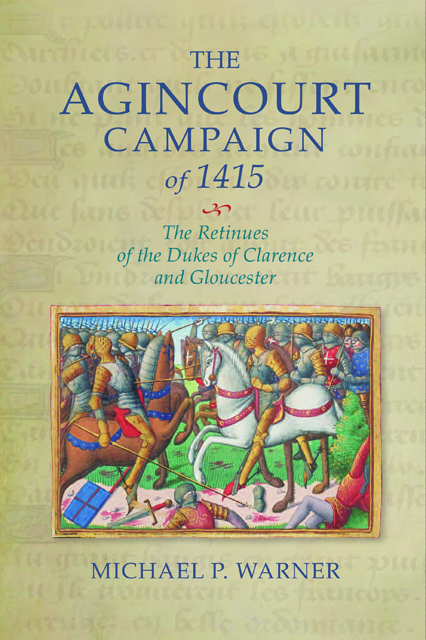Book contents
- Frontmatter
- Contents
- Lists of Tables and Charts
- List of Figures
- Acknowledgements
- Abbreviations
- Introduction
- 1 Before the Campaign
- 2 The Muster Rolls of the 1415 Expedition
- 3 Clarence’s and Gloucester’s 1415 Retinues
- 4 The Sub-Retinue Captains
- 5 During the Campaign
- 6 After the Campaign
- Conclusion
- Appendices
- Bibliography
- Index
- Warfare in History
1 - Before the Campaign
Published online by Cambridge University Press: 14 January 2023
- Frontmatter
- Contents
- Lists of Tables and Charts
- List of Figures
- Acknowledgements
- Abbreviations
- Introduction
- 1 Before the Campaign
- 2 The Muster Rolls of the 1415 Expedition
- 3 Clarence’s and Gloucester’s 1415 Retinues
- 4 The Sub-Retinue Captains
- 5 During the Campaign
- 6 After the Campaign
- Conclusion
- Appendices
- Bibliography
- Index
- Warfare in History
Summary
The Dynamics of Recruitment
In the indentures, sealed between retinue captains and the king on Monday, 29 April 1415, it was originally planned that the muster would take place on 1 July. This date came and went, however, as men from all across England and Wales slowly converged at their pre-assigned muster locations around Southampton. It was not until Sunday, 11 August that the English fleet finally set sail. To understand these men, some of whom had travelled hundreds of miles just to get to Southampton, and the army they collectively made up, one has to consider the evolution of the English military community during the previous century.
In the century between Bannockburn and Agincourt, as David Simpkin has written, ‘the size, structure and composition of [English] military retinues changed a great deal’, as did the military community. The term ‘military community’ is broad and refers to the ‘many thousands of men who served in English royal armies and garrisons during the Middle Ages’. The forces that drove these changes were numerous. They were both endogenous and exogenous, meaning they originated inside and outside of the English military recruitment system. To understand these forces, Ayton coined the phrase ‘dynamics of recruitment’. The term represents a conceptual model, which identifies and conceptualises the ‘circumstances and forces that, individually and through their interaction, contributed to, accompanied or were generated by the recruitment of armies in late medieval England’. Considering these circumstances and forces collectively, Ayton distinguished five key ‘agencies of change’ that contributed to the evolution of English war retinues and the military community in the ‘long’ fourteenth century.
The first of these was a change in England’s leading military captains during the middle of the fourteenth century, through either ‘death, retirement, redeployment to other responsibilities or political exclusion’, coupled with the emergence of new captains who built new affinities and recruitment networks, or at least altered existing ones. The other agencies of change were the strategy and war management of the Crown, how armies were raised and organised, developments overseas, including the opportunities for foreign service, for example in the Italian states, and the socio-economic and cultural conditions the military community found itself in during the late fourteenth century, particularly after the decimation of the population caused by plague.
- Type
- Chapter
- Information
- The Agincourt Campaign of 1415The Retinues of the Dukes of Clarence and Gloucester, pp. 10 - 30Publisher: Boydell & BrewerPrint publication year: 2021

